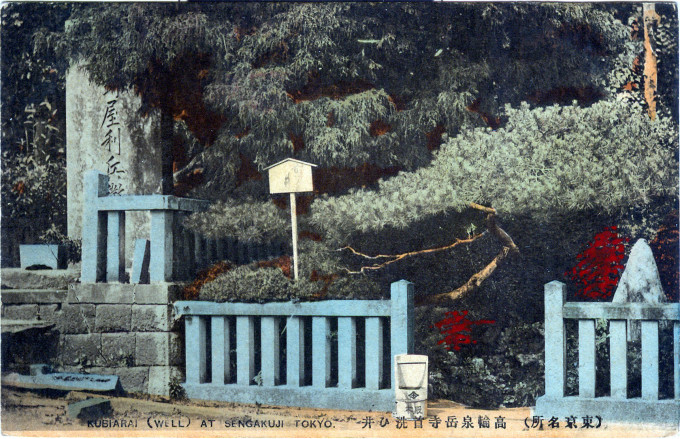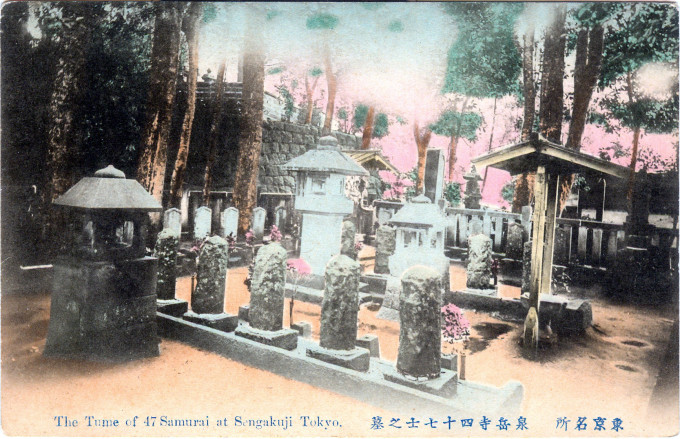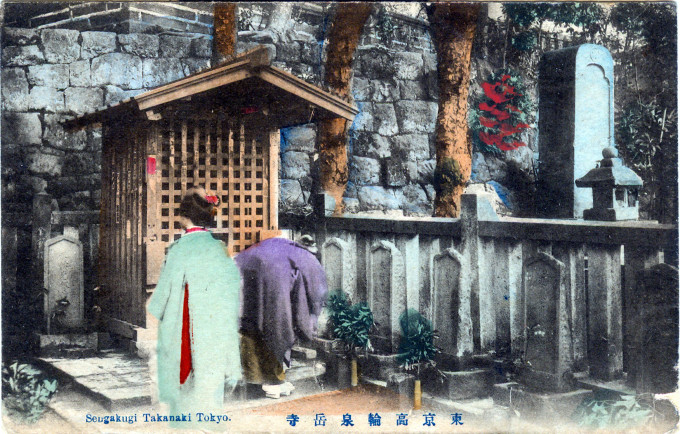
Kubiarai ido [well] at Sengakuji, Tokyo, c. 1920, where – in 1702 – Oishi, one of the 47 Ronin [masterless samurai], washed Kira’s decapitated head before presenting it at the grave of their master, Asano Naganori.
See also:
Daijo Of “Kanadehon chushingura” (The Treasury of Loyal Retainers), c. 1910.
Kabuki theater & actors, c. 1910.
“Tomb of Soga Brothers”, Hakone, c. 1920.
“In the midst of a nest of venerable trees in Takanawa, a suburb of Yedo, is hidden Sengakuji, or the Spring-hill Temple, renowned throughout the length and breadth of the land for its cemetery, which contains the graves of the forty-seven rônin, famous in Japanese history, heroes of Japanese drama.
“… And when they came to their lord’s grave, they took the head of Kozuke-no-suke, and having washed it clean in a well hard by, laid it as an offering before the tomb. When they had done this, they engaged the priests of the temple to come and read prayers while they burnt incense; first Oishi Kuranosuke burnt incense, and then his son Oishi Chikara, and after them the forty-five men performed the same ceremony. Then, Kuranosuke, having given all the money that he had by him to the abbot, said –
‘When we forty-seven men shall have performed hara-kiri, I beg you to bury us decently. I rely upon your kindness. This is but a trifle that I have to offer; such as it is, let it be spent in masses for our souls!‘”
– Tales of Old Japan, by A.B. Mitford, 1871
“The Revenge of the Forty-Seven Ronin, also known as the ‘Akō vendetta’ or the ‘Genroku Akō incident’, is an early 18th-century historical event and a legend in Japan in which a band of ronin (leaderless samurai) avenged the death of their master.
“The story tells of a group of samurai who were left leaderless (becoming ronin) after their daimyo (feudal lord) Asano Naganori was compelled to commit seppuku (ritual suicide) for assaulting a court official named Kira Yoshinaka, whose title was Kōzuke no suke. The ronin avenged their master’s honor by killing Kira, after waiting and planning for a year. In turn, the ronin were themselves obliged to commit seppuku for the crime of murder.
“This true story was popularized in Japanese culture as emblematic of the loyalty, sacrifice, persistence, and honor that people should preserve in their daily lives. The popularity of the tale grew during the Meiji era, during which Japan underwent rapid modernization, and the legend became entrenched within discourses of national heritage and identity.
The grave of Asano Takumi-no-Kami Naganori, at Sengakuji, Tokyo, c. 1910, whose act of seppuku was revenged by his now-masterless samurai.
“Before killing himself, Oishi chivalrously returned Kira’s head to his family. The receipt for ‘one head’ signed by the temple priests can still be seen in the museum. Osihi and his followers were buried at Sengakuji. Forty-seven simple stones are arranged in a square, with the larger tombs of Asano and his wife, and Oishi and his son, nearby.
“Fictionalized accounts of the tale of the Forty-seven Ronin are known as Chūshingura and the story has been popularized in numerous plays. The most successful of the adaptations was a Bunraku puppet play called Kanadehon Chūshingura (now simply called Chūshingura, or ‘Treasury of Loyal Retainers’), written in 1748 by Takeda Izumo and two associates; it was later adapted into a Kabuki play, which is still one of Japan’s most popular.”
– Wikipedia




Pingback: Hanayashiki, Asakusa Park, c. 1920. | Old Tokyo
Pingback: Kabuki theater & Kabuki actors, c. 1910. | Old Tokyo
Pingback: "Tomb of Soga Brothers", Hakone, c. 1920. | Old Tokyo
Pingback: Daijo Of "Kanadehon chushingura" (The Treasury of Loyal Retainers), c. 1910. | Old Tokyo